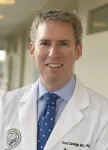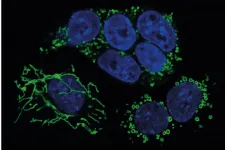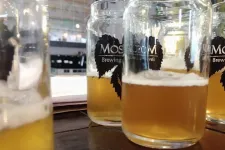New algorithm may help autonomous vehicles navigate narrow, crowded streets
CMU research could help solve last mile delivery challenges
2021-07-20
(Press-News.org) It is a scenario familiar to anyone who has driven down a crowded, narrow street. Parked cars line both sides, and there isn't enough space for vehicles traveling in both directions to pass each other. One has to duck into a gap in the parked cars or slow and pull over as far as possible for the other to squeeze by.
Drivers find a way to negotiate this, but not without close calls and frustration. Programming an autonomous vehicle (AV) to do the same -- without a human behind the wheel or knowledge of what the other driver might do -- presented a unique challenge for researchers at the Carnegie Mellon University Argo AI Center for Autonomous Vehicle Research.
"It's the unwritten rules of the road, that's pretty much what we're dealing with here," said Christoph Killing, a former visiting research scholar in the School of Computer Science's Robotics Institute and now part of the Autonomous Aerial Systems Lab at the Technical University of Munich. "It's a difficult bit. You have to learn to negotiate this scenario without knowing if the other vehicle is going to stop or go."
While at CMU, Killing teamed up with research scientist John Dolan and Ph.D. student Adam Villaflor to crack this problem. The team presented its research, "Learning To Robustly Negotiate Bi-Directional Lane Usage in High-Conflict Driving Scenarios," at the International Conference on Robotics and Automation.
The team believes their research is the first into this specific driving scenario. It requires drivers -- human or not -- to collaborate to make it past each other safely without knowing what the other is thinking. Drivers must balance aggression with cooperation. An overly aggressive driver, one that just goes without regard for other vehicles, could put itself and others at risk. An overly cooperative driver, one that always pulls over in the face of oncoming traffic, may never make it down the street.
"I have always found this to be an interesting and sometimes difficult aspect of driving in Pittsburgh," Dolan said.
Autonomous vehicles have been heralded as a potential solution to the last mile challenges of delivery and transportation. But for an AV to deliver a pizza, package or person to their destination, they have to be able to navigate tight spaces and unknown driver intentions.
The team developed a method to model different levels of driver cooperativeness -- how likely a driver was to pull over to let the other driver pass -- and used those models to train an algorithm that could assist an autonomous vehicle to safely and efficiently navigate this situation. The algorithm has only been used in simulation and not on a vehicle in the real world, but the results are promising. The team found that their algorithm performed better than current models.
Driving is full of complex scenarios like this one. As the autonomous driving researchers tackle them, they look for ways to make the algorithms and models developed for one scenario, say merging onto a highway, work for other scenarios, like changing lanes or making a left turn against traffic at an intersection.
"Extensive testing is bringing to light the last percent of touch cases," Dolan said. "We keep finding these corner cases and keep coming up with ways to handle them."
INFORMATION:
[Attachments] See images for this press release:

ELSE PRESS RELEASES FROM THIS DATE:
2021-07-20
Wind energy is of outstanding importance to the energy transition in Germany. According to the Federal Statistical Office, its share in total gross electricity production of about 24% is far higher than those of all other renewable energy sources. "To reach our climate goals, it is important to further expand these capacities and to replace as much coal-based power as possible," says Professor Wolf Fichtner from KIT's Institute for Industrial Production (IIP). "However, there is considerable resistance, especially in beautiful landscapes." A team of researchers from KIT, the University of Aberdeen, and the Technical University of Denmark has now calculated what this means for the costs ...
2021-07-20
The photovoltaic effect of ferroelectric crystals can be increased by a factor of 1,000 if three different materials are arranged periodically in a lattice. This has been revealed in a study by researchers at Martin Luther University Halle-Wittenberg (MLU). They achieved this by creating crystalline layers of barium titanate, strontium titanate and calcium titanate which they alternately placed on top of one another. Their findings, which could significantly increase the efficiency of solar cells, were published in the journal Science Advances.
electric crystals do not require a so-called pn junction to create the photovoltaic effect, in other words, no positively and negatively doped layers. This makes it much easier to produce ...
2021-07-20
A study led by D. Ross Camidge, MD, PhD, director of thoracic oncology at the University of Colorado School of Medicine and CU Cancer Center member, has helped to define MET amplification as a rare but potentially actionable driver for non-small cell lung cancer (NSCLC).
Camidge says many of the major developments in the treatment of non-small cell lung cancer have come from defining molecularly specific subsets of the disease for which researchers have been able to develop targeted treatments. Until now, all of these subsets have been based on either genetic mutations or gene rearrangements ...
2021-07-20
As multicellular life relies on cell-cell interactions, it is not surprising that this is not always peaceful: cells with higher fitness eliminate cells with lower fitness through cell competition. Cell competition has emerged as a quality control mechanism and occurs when cells differ, genetically or otherwise, from each other. In mammals, the process of cell competition has been observed e.g., in cancer, during organ homeostasis, and during development as a process to select the fittest cells in the embryo and the adult. However, the features that distinguish "winner" from "loser" cells and whether there are key determinants for cell competition in various biological ...
2021-07-20
PULLMAN, Wash. - When it comes to craft beer, the flavor doesn't have to be all in the hops. As a panel of amateur beer tasters at Washington State University recently demonstrated, malted barley, the number one ingredient in beer besides water, can have a range of desirable flavors too.
Researchers recruited a panel of about 100 craft beer drinkers to taste some so-called SMaSH beers--those brewed with a single barley malt and single hop. All the beers contained the same hop variety, called Tahoma, but each had a malt from a different barley genotype, or genetic makeup. Trained tasters can distinguish these easily, but even the untrained ...
2021-07-20
An international group of researchers representing thousands of coral scientists across the globe is calling for new commitments and actions by the world's policymakers to protect and restore coral reefs.
In a paper presented July 20 at the International Coral Reef Symposium, the scientists said that the coming decade will likely offer the last chance for policymakers at all levels to prevent coral reefs "from heading towards world-wide collapse."
The paper, developed by the International Coral Reef Society, pushes for three strategies to save the reefs: addressing climate change, improving local conditions and actively restoring coral. ...
2021-07-20
The female tsetse fly, which gives birth to adult-sized live young, produce weaker offspring as they get older, and when they feed on poor quality blood.
The study, carried out by researchers at the Universities of Bristol, Oxford and the Liverpool School of Tropical Medicine, was designed to measure how tsetse offspring health is influenced by their mothers' age, and how factors such as the mother's nutrition and mating experience might come into play.
In many animals, females show signs of reproductive ageing - where offspring health declines with maternal age - but there is huge variation within species in how rapidly this ageing occurs.
Scientists found that female tsetse that experience ...
2021-07-20
For more than 20 years, Makoto Miyata from Osaka City University has been studying the gliding motility of the parasitic bacterium Mycoplasma mobile (M. mobile). It is a mechanism consisting of an external "grabbing" structure and internal "motor" - the motor having yet to be clarified on a molecular level. In collaboration with Osaka University and Kanazawa University, his research team used electron microscopy and high-speed atomic force microscopy (high-speed AFM) to reveal that the bacteria's molecular motor consists of two ATP synthase-like complexes, suggesting an unexpected evolution of the protein. Their findings were published in mBio.
Based on genetic information, researchers have suggested that the ...
2021-07-20
Imagine you're a CEO who wants to promote an innovative new product -- a time management app or a fitness program. Should you send the product to Kim Kardashian in the hope that she'll love it and spread the word to her legions of Instagram followers? The answer would be 'yes' if successfully transmitting new ideas or behavior patterns was as simple as showing them to as many people as possible.
However, a forthcoming study in the journal Nature Communications finds that as prominent and revered as social influencers seem to be, in fact, they are unlikely to change a person's behavior by example -- and might actually be detrimental to the cause.
Why?
"When social influencers present ideas that are ...
2021-07-20
A new scoping review found that those with chronic health concerns, such as diabetes, heart disease, cancer, and autoimmune conditions, are not only at a higher risk of severe COVID-19 infection, they are also more likely to experience anxiety, depression or substance use during the COVID-19 pandemic.
The aim of the review was to address knowledge gaps related to the prevention and management of mental health responses among those with chronic conditions. The findings, recently published in the International Journal of Environmental Research and Public Health, were based on a comprehensive review of 67 Chinese and English-language studies.
"Levels ...
LAST 30 PRESS RELEASES:
[Press-News.org] New algorithm may help autonomous vehicles navigate narrow, crowded streets
CMU research could help solve last mile delivery challenges





